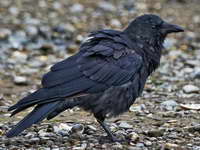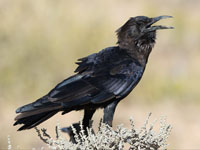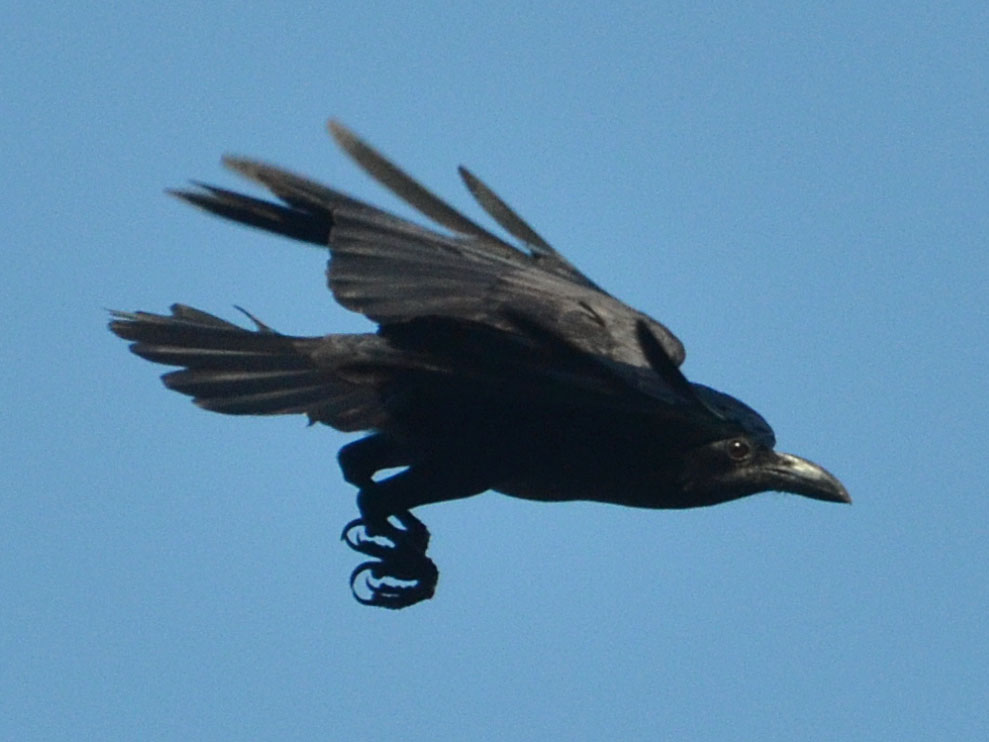The Corvidae family contains the crows, ravens, rooks, jackdaws, jays, magpies, treepies, choughs and nutcrackers. These species are grouped into subfamilies that are outlined in the table that follows. Beware that names such as jays, magpies, or treepies are not always assigned in a consistant manner. For example, the black magpie (Platysmurus leucopterus) belongs to the treepie subfamily.
| SUBFAMILY | MEMBERS |
| Corvinae | True crows of genus Corvus includes the crows, ravens, rooks, jackdaws. |
| Corvinae (continued) | Jays of genus Garrulus, nutcrackers of Nucifraga, magpies of Pica, ground-jays of Jay Podoces, and the piapiac of Ptilostomus, and Stresemann's bush-crow of Zavattariornis. |
| Cissinae | Green-magpies of Cissa and the blue-magpies of Urocissa. |
| Cyanocoracinae | Most of the species that are named "jay". |
| Crypsirininae | Treepies |
| Perisoreinae | Three jay species of Perisoreus and Magpies of Cyanopica |
This article describes the species in the Corvus genus which contains the crows, jackdaws, ravens and rooks. Tthe Corvinae subfamily also contains genera Garrulus, Nucifraga, Pica, Podoces, Ptilostomus, and Zavattariornis. These genera will be described in a separate article.
Genus Corvus
The genus Corvus consists of relatively large birds that are are either black all over, or mainly black with white or grey patches. In most species, nasal bristles cover the nostrils. They range in size from the relatively small jackdaws to the very large common raven.
The 40 plus members of this genus occur on all continents except South America and Antarctica.
Crows and the other members of Corvus are among the most intelligent of birds. Some even make and use tools to help gather food. They have even learned how to used drinking fountains, adjusting the flow to be appropriate for drinking or bathing. Most crows are social and will gather in large communal roosts numbering. They make a wide variety of calls or vocalization, presumbably conveying different information in different circumstances.
Intelligence and social structures make most crow species adaptable and opportunistic.
Crows are omnivorous. They often seem to eat whatever is available: - plants or animals, dead or alive. They can be a pest getting into garbage bags and fields of grain. The scarecrow exists because farmers for centuries have consider crow as pests. And yes, they do damage to crops, but they also assist by eating insects and thus also prevent crop damage. It usually takes more than just a scarecrow to deter crows, so guns and poison may be resorted to. The crows intelligence usually prevents decimation of a species.
Many of the crow species described here exist because a wide spread species managed to breed on an isolated location such as an island. The offspring sometimes evolved special characteristics that helped them thrive in that location and they eventually became different enough from their ancestors to be considered to be a new species. However, if the new species has a limited range, that could put it in danger of extinction because of a change in its food supply. Also, if humans modified their enviroment, for exampe by logging, that could be deadly too.
Crow,_American Corvus brachyrhynchos Found: North America
Range: North America from northern Mexico to Alaska and Canada.
Habitat: Most places except Pacific rainforest and northern tundra.
Diet: Snakes, frogs, small mammels, eggs, chicks, seeds fruit, and much more. They are famous for their cunning in their ability to obtain human food remains.
Conservation status: Least Concern.




Crow,_Northwestern Corvus brachyrhynchos caurinus
Range: Pacific coastal area from Washington to Alaska.
Habitat: Coastal.
Diet: Fish, mollusks.
Conservation status: Least Concern.



Crow,_Banggai Corvus unicolor
Range: Banggai Island which is east of Sulawesi. Indonesia
Habitat: Mountain forest above 500 meters.
Diet: Anthropods such as crustacean and insects.
Conservation status: It is listed as Critiaclly Endangered due to habitat reduction via agriculture. The population is about 500.

Crow,_Bismarck Corvus insularis
Range: Bismarck Archipelago (near New Guinea) .
Habitat: Varied, rarely in dense forest.
Diet: Insects, fruit.
Conservation status: Least Concern.
Crow,_Bougainville Corvus meeki
Range: Bougainville in Papua New Guinea and the neighbouring Shortland Islands in the Solomon Islands.
Habitat: Rainforest, forest edge, plantations and gardens.
Diet: Insects, fruit.
Conservation status: Least Concern.
Crow,_Brown-headed Corvus fuscicapillus
Range: Near New Guinea.
Habitat: Moist lowland forests, mangroves.
Diet: Fruit.
Conservation status: The brown-headed crow is listed as Near Threatened because it has a restricted range and an apparent low popupalation.
Crow,_Cape Corvus capensis
Range: Eastern and southern Africa.
Habitat: Open grassland, moorland, agricultural areas with some trees or woodland in the vicinity for nesting.
Diet: Invertebrates, grain and other seeds, bulbs, roots, fruit, frogs, small reptiles.
Conservation status: Least Concern.



Crow,_Carrion Corvus corone
Range: Western Europe (England, France, Iberian Peninsula), Iran to north China, Korea.
Habitat: Various, likes to have at least a few trees.
Diet: Mainly invertebrates such as worms, Also carrion, frogs, eggs, chicks, seeds.
Conservation status: Least Concern.



Crow,_Collared Corvus pectoralis also Corvus torquatus
Range: China.
Habitat: Areas with scattered trees near water, especially rice fields.
Diet: Insects, invertebrates such as mollusks, grains especially rice, human garbage. Also carrion, eggs, chicks.
Conservation status: It is listed as Vulnerable due to pesticides.



Crow,_Cuban Corvus nasicus
Range: Cuba and nearby islands.
Habitat: Substantial tree cover, forest edges, cultivated areas.
Diet: Invertebrates, fruit.
Conservation status: Least Concern.



Crow,_Fish Corvus ossifragus
Range: East and south North America.
Habitat: Coastal marshes and beaches, rivers, inland lakes and marshes, river banks, and the land immediately surrounding.
Diet: Crabs, shrimp, abandoned fish, live fish, eggs, chicks, small reptiles, fruit.
Conservation status: Least Concern.




Crow,_Flores Corvus florensis
Range: Lesser Sunda Islands of Indonesia.
Habitat: Primary forests and secondary forests that have enough tall trees.
Diet: Probably invertebrates and fruit.
Conservation status: The Flores crow is listed as Endangered because of deforestation.

Crow,_grey Corvus tristis
Range: New Guinea and some offshore islands.
Habitat: Forests, both primary and secondary.
Diet: Fruit, small animals such as frogs, insects, larvae.
Conservation status: Least Concern.

Crow,_Hawaiian Corvus hawaiiensis
Range: Hawaii.
Habitat: It used to be found in forests and woodlands, now there are only captive birds.
Diet: Fruit, invertebrates, eggs, chicks.
Conservation status: The Hawaiian crow is Extinct in the Wild. This extinction was due to shooting and poisoning. Also, habitat degradation has been a problem for the.

Crow,_Hooded Corvus cornix
Range: Europe, Asia.
Habitat: Open land with scattered trees. Found inland and coastal areas.
Diet: Mainly invertebrates such as worms, Also carrion, frogs, eggs, chicks, seeds.
Conservation status: Least Concern.




Crow,_House Corvus splendens
Range: Asia, Africa, Australasia.
Habitat: Near humans in topical and semi-tropical settings.
Diet: Mainly human garbage. Also carrion, crops, small animals, invertebrates
Conservation status: Least Concern.

Crow,_Jamaican Corvus jamaicensis
Range: Jamaica
Habitat: Hill and mountain forest. It comes down to lower elevations during the dry season where it is more likely to be seen.
Diet: Mainly fruit, also invertebrates and lizards.
Conservation status: Least Concern.


Crow,_Large-billed Corvus macrorhynchos
Range: Eastern Asia including Japan.
Habitat: Woodland, parks and gardens, cultivated regions with at least some trees.
Diet: Extremely varied diet - what is available - plants or animials, dead or alive. It can be a pest getting into garbabe bags.
Conservation status: Least Concern.



Crow,_Little Corvus bennetti
Range: Western and central Australia.
Habitat: Avoids tropical wetland. Prefers dry areas.
Diet: Insects, cereals and other seeds. It is less of a scavenger than the Torresian crow.
Conservation status: Least Concern.


Crow,_Long-billed Corvus validus
Range: Maluku Islands of Indonesia .
Habitat: Primary and secondary forests, coconut plantations.
Diet: Information needed.
Conservation status: The long-billed crow is listed as Near Threatened because of its restricted range and there is logging in that range. That said, the population may still be substantial.

Crow,_Mariana Corvus kubaryi
Range: Northern Marianas Islands, Guam, and vicinity.
Habitat: Primary and secondary forests as well as coastal strand vegetation. However, it only nests in a few species of tall trees that emerge from the canopy.
Diet: Insects, lizards, other birds' eggs, hermit crabs, fruits, and seeds.
Conservation status: It is Critically Endangered because of loss of habitat and also from predators such as the brown tree snake.

Crow,_New Caldonian Corvus moneduloides
Range: New Caldonia (islands east of Australia).
Habitat: A generalist, found in forests to savannas.
Diet: A wide range of food, including many types of invertebrates, eggs, nestlings, small mammals, snails, nuts and seeds. It has been known to capture grubs by using a twig, that is by using a tool!
Conservation status: Least Concern.
1) Juvenile



Crow,_Palm Corvus palmarum
Description: The palm crow is a relatively small black crow, similar to a minature raven. Unlike a raven with its white eyes, the palm crow was brown eyes. It has a simple and repetitive call cao. The palm crow is 34 to 38 cm long. The mostly source of confusion in identifying this crow would be the white-necked crow of Hispaniola which has orange-red or yellow eyes instead of the palm crow's brown eyes.
Range: Cuba (rare), Hispaniola. On Cuba
Habitat: Pine forests, mixed pine forests, scrub, corn fields.
Diet: Invertebrates such as beetles and caterpillars, lizards, fruit.
Conservation status: Least Concern.



Crow,_Pied Corvus albus
Range: Sub-Saharan Africa.
Habitat: Mainly open country with villages and towns nearby.
Diet: Insects, reptiles, small mammals, eggs, chicks, grain, peanuts, carrion, fruit, human garbage.
Conservation status: Least Concern.




Crow,_Piping Corvus typicus
Range: Sulawesi (Indonesia).
Habitat: Subtropical or tropical moist lowland forest.
Diet: Pnsects, larvae, fruit.
Conservation status: Least Concern.


Crow,_Sinaloa Corvus sinaloae
Range: Western Mexico.
Habitat: Coastal regions where it forages on the seashore, semi-desert, open woodlands, river banks.
Diet: Insects, crabs, fruit. Also, eggs, chicks.
Conservation status: Least Concern.


Crow,_Slender-billed Corvus enca
Range: Brunei, Indonesia, Malaysia, and the Philippines.
Habitat: Near primary and secondary evergreen forests; especially forest edges, clearings, and villages.
Diet: Fruit, insects, beetles, lizards.
Conservation status: Least Concern.




Crow,_Somali Corvus edithae
Range: East Africa.
Habitat: Open areas: deserts to dry savanna.
Diet: Insects, reptiles, small mammals, eggs, chicks, grain, carrion, fruit, human garbage.
Conservation status: Least Concern.



Crow,_Tamaulipas Corvus imparatus
Range: Northeast Mexico; also southern Texas.
Habitat: Dry country, near human settlements, garbage dumps.
Diet: Insects, seeds, fruit, carrion, garbage, eggs, chicks.
Conservation status: Least Concern.



Crow,_Torresian Corvus orru
Range: Mainly Australia, also New Guinea.
Habitat: Almost any habitat within its geographic range where there is a permanent source of water.
Diet: Invertebrates, fruit, carrion, small birds and rodents. Even eats the poisonous cane toad by feeding on just the intestines and part of the thighs of the toad, thus avoiding the poison.
Conservation status: Least Concern.
1) Bird on left has white visible on its neck.




Crow,_White-billed Corvus woodfordi
Range: Solomon Islands (east of New Guinea).
Habitat: Mainly rainforest; also forest edges and clearings.
Diet: Insects, fruit. It is usually hidden in the foest canopy.
Conservation status: Least Concern.

Crow,_White-necked Corvus leucognaphalus
Range: Hispaniola.
Habitat: Mature forests. Also cactus swamps and mangroves.
Diet: Fruit, insects, eggs, chicks.
Conservation status:The white-necked crow is listed as Vulnerable because of declining population due to logging and hunting. Also, it has a restricted ranged.



Jackdaw, Daurian Corvus dauuricus
Range: Eastern Asia.
Habitat: Open country with some trees available.
Diet: Mainly grain, seeds, and berries. During breeding season, caterpillars, grasshoppers, ant, flies.
Conservation status: Least Concern.



Jackdaw, Eurasian Corvus monedula
Range: Europe, western Asia, northern Africa.
Habitat: Open country with some trees available.
Diet: Mainly grain, seeds, and berries. During breeding season, caterpillars, grasshoppers, ant, flies, eggs.
Conservation status: Least Concern.




RAVENS
The ravens ares larger-bodied members of the genus Corvus. Most have black plumage and large beaks but their plumage can differ slightly in some species. Most species have dark brown irises but a few in Australia have white irises.
Raven,_Australian Corvus coronoides Found: Australia
Range: Southwestern and eastern Australia.
Habitat: Trees for perching. Where its range overlaps with the little raven, the Australian raven chooses more wooded areas.
Diet: Mainly invertebrates, eggs, chicks, carrion. Also seeds, fruit.
Conservation status: Least Concern.



Raven,_Brown-necked Corvus ruficollis
Range: North Africa, southwest Asia.
Habitat: Predominantly desert environment visiting oases and palm groves.
Diet: Carrion, snakes, grasshoppers, stranded fish, grain, dates, fruits.
Conservation status: Least Concern.




Raven,_Chihuahuan Corvus cryptoleucus
Range: Southwest USA, Mexica.
Habitat: Grasslands with scattered trees.
Diet: Grains, insects and many other invertebrates, small reptiles, carrion, cactus fruits, eggs and nestlings.
Conservation status: Least Concern.




Raven,_Common Corvus corax
Range: North America, Europe, Asia, Africa. It is the most widly distributed corvid.
Habitat: Prefer wooded areas with large expanses of open land nearby, or coastal regions for their nesting sites and feeding grounds.
Diet: Varies widely with location, season, and available food supply. Food includes rodents, carrion, eggs, chicks, amphibians, reptiles, garbage, grains, fruit.
Conservation status: Least Concern.




Raven,_Fan-tailed Corvus rhipidurus
Range: Southwest Asia, central and eastern Africa.
Habitat: Desert or open dry country that includes crags for nesting.
Diet: Invertebrates such as insects, grain, carrion, garbage, fruit. It is one of the most aerial of ravens traveling huge distances in search of food, its large wings being adapted to gliding on thermals,
Conservation status: Least Concern.



Raven,_Forest Corvus tasmanicus
Range: Southeatern Australia, Tasmania
Habitat: A wide variety of habitats in Tasmania but is restricted to more closed forest on mainland Australia.
Diet: Mainly meat such as insects, carrion, worms, eggs, chicks, crabs. Also grains, fruit.
Conservation status: Least Concern.



Raven,_Little Corvus mellori
Range: Southeastern Australia.
Habitat: Varied habitat, but not dense forests.
Diet: Insects, carrion, eggs, chicks, fruit.
Conservation status: Least Concern.



Raven,_Thick-billed Corvus crassirostris
Range: Ethiopia, Eritrea, and nearby countries in northeast Africa
Habitat: Hilly and mountainous areas, .
Diet: Grubs, locusts, beetle larvae from animal dung, carrion, scraps of meat and human food.
Conservation status: Least Concern.
1) Pair



Raven,_White-necked Corvus albicollis
Range: Eastern and southern Africa
Habitat: Open, mountainous country. It is quite commonly found in small towns and villages as long as there are mountains or hills for roosting and nesting relatively nearby.
Diet: Grubs, locusts, beetle, lizards, small animals, small birds, eggs, corn, peanuts, fruit.
Conservation status: Least Concern.




Rook Corvus frugilegus
Range: Europe, Asia, New Zealand (introduced) .
Habitat: Generally lowland birds, with most rookeries found below 120 m. They are comfortable in more open areas than the common raven, as long as there are a few tall trees.
Diet: Manily plant material such as cereals, potatoes, roots, fruit, acorns, berries and seeds. Also beetles, spiders, millipedes, slugs, snails, small mammals, eggs, chicks, small birds.
Conservation status: Least Concern.



